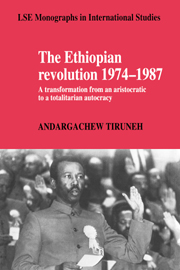 The Ethiopian Revolution 1974–1987
The Ethiopian Revolution 1974–1987 Book contents
- Frontmatter
- Contents
- List of maps and tables
- Acknowledgements
- List of abbreviations
- Map 1 The Horn of Africa
- Map 2 Administrative divisions
- 1 The background to the emergence of the structural crisis
- PART I THE COLLAPSE OF THE OLD-STATE (JANUARY–NOVEMBER 1974)
- 2 The urban uprising of January to June 1974
- 3 The turning of an urban movement into a junta dictatorship
- PART II THE FORMATIVE YEARS OF THE POST-REVOLUTIONARY ORDER (DECEMBER 1974–FEBRUARY 1977)
- PART III CONSOLIDATION OF POWER (FEBRUARY 1977–SEPTEMBER 1987)
- Postscript
- Appendix: chronology of events
- Notes
- Bibliography
- Index
- LSE MONOGRAPHS IN INTERNATIONAL STUDIES
3 - The turning of an urban movement into a junta dictatorship
Published online by Cambridge University Press: 18 December 2009
- Frontmatter
- Contents
- List of maps and tables
- Acknowledgements
- List of abbreviations
- Map 1 The Horn of Africa
- Map 2 Administrative divisions
- 1 The background to the emergence of the structural crisis
- PART I THE COLLAPSE OF THE OLD-STATE (JANUARY–NOVEMBER 1974)
- 2 The urban uprising of January to June 1974
- 3 The turning of an urban movement into a junta dictatorship
- PART II THE FORMATIVE YEARS OF THE POST-REVOLUTIONARY ORDER (DECEMBER 1974–FEBRUARY 1977)
- PART III CONSOLIDATION OF POWER (FEBRUARY 1977–SEPTEMBER 1987)
- Postscript
- Appendix: chronology of events
- Notes
- Bibliography
- Index
- LSE MONOGRAPHS IN INTERNATIONAL STUDIES
Summary
THE EMERGENCE OF THE DERG
In the organizations in which the members had unions or associations, the task of co-ordinating the demands, strikes and demonstrations of February–June 1974 fell on the democratically elected leaders and committees. Examples of these were the Confederation of Ethiopian Labour Unions (CELU), the Ethiopian Teachers' Association and the University Students' Union of Addis Ababa. In the other organizations, spontaneous committees sprang up in the course of the movement and took on the task of co-ordinating the protest activities in their respective organizations. Also, in some of the provincial capitals, notably in Jimma (Kefa), committees made up of similar corporate groups went as far as temporarily occupying the local administrations and setting themselves up as popular governments, albeit for a short time. Needless to say, the most active in all these committees were the radical left.
According to Lefort, the emergence of Co-ordinating Committees within the army goes as far back as late 1973, when what he calls ‘Army Mess Committees’ started compiling lists of strictly corporatist grievances, at the instigation of senior officers who sought to create discontentment among the army against the prime minister (Aklilou Habte-Wolde). By the end of February 1974, highly politicized unit co-ordinating committees were established at least in the air force and in the First, Second and Fourth Divisions and spread to the remaining units thereafter. The Military–Police Co-ordinating Committees (like the ones that emerged in February and April) were different from what we have called ‘the unit co-ordinating committees’ in that they purported to represent all or most of the units instead of individual ones.
- Type
- Chapter
- Information
- The Ethiopian Revolution 1974–1987A Transformation from an Aristocratic to a Totalitarian Autocracy, pp. 60 - 82Publisher: Cambridge University PressPrint publication year: 1993


